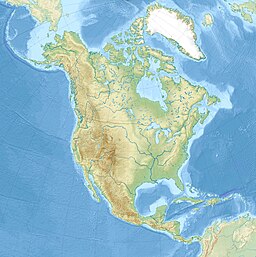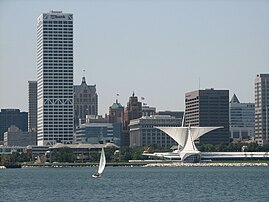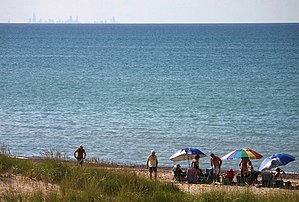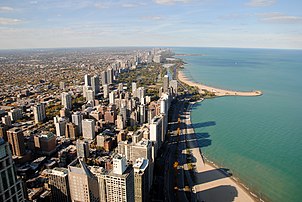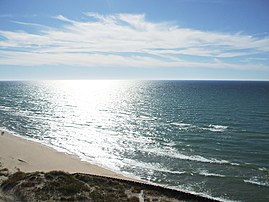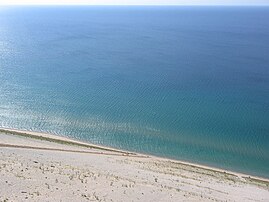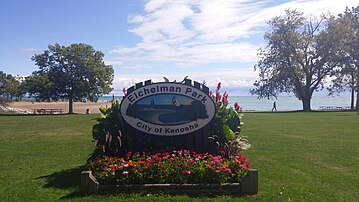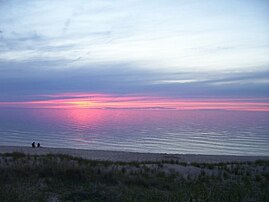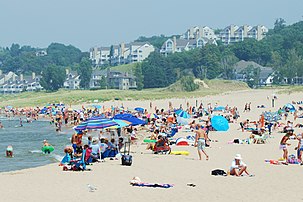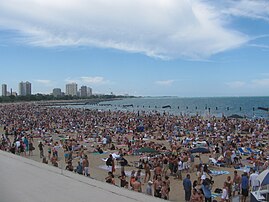Lake Michigan
| Lake Michigan | |
|---|---|
| Ininwewi-gichigami(Ojibwe) | |
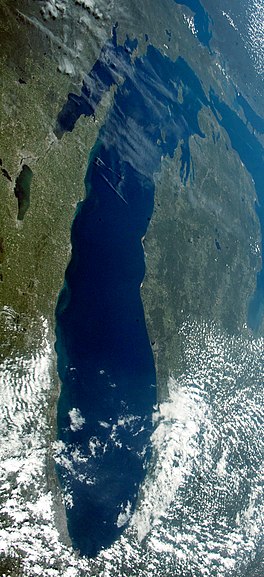 Lake Michigan viewed from theInternational Space Station(August 19, 2019).Chicagosits at the extreme S.W. of the lake. | |
 | |
| Location | United States |
| Group | Great Lakes |
| Coordinates | 44°N87°W/ 44°N 87°W |
| Lake type | Glacial |
| Primary inflows | Straits of Mackinac,Fox River,Grand River,Menominee River,Milwaukee River,Muskegon River,Kalamazoo River,St. Joseph River |
| Primary outflows | Straits of Mackinac;also, controlled discharge through locks on theChicago River(and itsNorth Shore Channel), andCalumet River |
| Basincountries | United States |
| Max. length | 307 mi (494 km) |
| Max. width | 118 mi (190 km) |
| Min. width | 91 mi (146 km) |
| Surface area | 22,404 sq mi (58,030 km2)[5] |
| Average depth | 279 ft (85 m) |
| Max. depth | 923 ft (281 m)[6] |
| Water volume | 1,183 cu mi (4,930 km3) |
| Residence time | 99 years |
| Shore length1 | 1,400 mi (2,300 km) plus 238 mi (383 km) for islands[7] |
| Surface elevation | 577 ft (176 m)[6] |
| Islands | seelist |
| Settlements | seelist |
| References | [6] |
| 1Shore length isnot a well-defined measure. | |
Lake Michigan(/ˈmɪʃɪɡən/MISH-ig-ən) is one of the fiveGreat LakesofNorth America.It is the second-largest of the Great Lakes by volume[5](1,180 cu mi (4,900 km3)) and the third-largest by surface area (22,405 sq mi (58,030 km2)), afterLake SuperiorandLake Huron.To the east, its basin is conjoined with that of Lake Huron through the3+1⁄2-mile (5.6-kilometer) wide, 295-foot (90-meter; 49-fathom) deep[8]Straits of Mackinac,giving it the same surface elevation as its easterly counterpart; geologically, the two bodies area single lakethat is, by area, the largest freshwater lake in the world.[9]
Lake Michigan is the only Great Lake located fully in the United States; the other four are shared between the U.S. and Canada. It is the world'slargest lake,by area, located fully in one country,[10]and is shared, from west to east, by the U.S. states ofWisconsin,Illinois,Indiana,andMichigan.Ports along its shores includeChicago,Illinois,Gary,Indiana,MilwaukeeandGreen Bay,Wisconsin, andMuskegon,Michigan. To the north, the lake is flanked by longbays,includingGreen Bayin the northwest, andGrand TraverseandLittle Traversebays in the northeast. The wordmichiganis believed to come from theOjibweᒥᓯᑲᒥ[11](michi-gamiormishigami), meaning "great water".[12]
History
[edit]Some of the most well-studied early human inhabitants of the Lake Michigan region were theHopewell Native Americans.Their culture declined after 800 AD, when, for the following few hundred years, the region was the home of peoples known as theLate Woodland Native Americans.In the early 17th century, when Western European explorers made their first forays into the region, they encountered descendants of the Late Woodland Native Americans, mainly the historicChippewa,Menominee,Sauk,Fox,Winnebago,Miami, OttawaandPotawatomipeoples. TheFrenchexplorerJean Nicoletis believed to have been the first European to reach Lake Michigan, possibly in 1634 or 1638.[13]In the earliest European maps of the region, the name ofLake Illinoishas been found (named for theIllinois Confederationof tribes),[14]in addition to that of "Michigan". During the 1640s and 1650s, theBeaver Wars(over thefur tradewith the European colonies), initiated by theIroquois,forced a massive demographic-shift, as their western neighbors fled the violence. The Iroquois sought refuge to the west and north of Lake Michigan.[15]
The Straits of Mackinac were an important Native American travel corridor and fur-trade route. Located on the southern side of the straits sits the town ofMackinaw City, Michigan,the site ofFort Michilimackinac(a reconstructed French fort founded in 1715); on the northern side isSt. Ignace, Michigan,site of a French Catholic mission to the Indians (founded in 1671). In 1673,Jacques Marquette,Louis Jolliet,and their crew of fiveMétisvoyageursfollowed Lake Michigan to Green Bay and up theFox River,nearly to its headwaters,in their search for theMississippi River.By the late 18th century, the eastern portions of the straits were controlled byFort MackinaconMackinac Island,aBritish colonialand earlyAmerican militarybase and fur trade center, founded in 1781.[16]
With the advent of European exploration into the area in the late 17th century, Lake Michigan became used as part of a line of waterways leading from theSaint Lawrence Riverto the Mississippi River and thence to theGulf of Mexico.[17]Frenchcoureurs des boisand voyageurs established small ports and trading communities, such as Green Bay, on the lake during the late 17th and early 18th centuries.[18]In the 19th century, Lake Michigan was integral to the development ofChicagoand theMidwestern United Stateswest of the lake. For example, 90% of the grain shipped from Chicago traveled by ships east over Lake Michigan during theantebellumyears. The volume rarely fell below 50% after theCivil Wareven with themajor expansion of railroad shipping.[19]
The first person to reach the deep bottom of Lake Michigan wasJ. Val Klump,a scientist at theUniversity of Wisconsin–Milwaukeein 1985. Klump reached the bottom viasubmersibleas part of a research expedition.[20]The warming of Lake Michigan was the subject of a 2018 report byPurdue University.In each decade since 1980, steady increases in obscure surface temperature have occurred. This is likely to lead to decreasing native habitat and to adversely affect native species survival, including game fish.[21]
Hydrology
[edit]
TheMilwaukee Reef,running under Lake Michigan from a point between Milwaukee and Racine to a point between Grand Haven and Muskegon, divides the lake into northern and southern basins. Each basin has a clockwise flow of water, deriving from rivers and winds. Prevailing westerly winds tend to move the surface water toward the east, producing a moderating effect on the climate of western Michigan. There is a mean difference in summer water temperatures of 5 to 10 degrees Fahrenheit (2 to 5 degrees Celsius) between the Wisconsin and Michigan shores.[22]
Hydrologically Michigan and Huron are the same body of water (sometimes calledLake Michigan-Huron) but are normally considered distinct. Counted together, it is the largest body of fresh water in the world by surface area. TheMackinac Bridgeis generally considered the dividing line between them. The main inflow to Lake Michigan from Lake Superior, through Lake Huron, is controlled by the locks operated by the bi-nationalLake Superior Board of Control.[23]
Statistics
[edit]
Lake Michigan is the only Great Lake that is wholly within the borders of the United States; the others are shared with Canada.[24]Lake Michigan has a surface area of 22,404 sq mi (58,030 km2); (13,237 square miles (34,280 km2) lying in Michigan,[6]7,358 square miles (19,060 km2) in Wisconsin, 234 square miles (610 km2) in Indiana, & 1,576 square miles (4,080 km2) in Illinois) making it the largest lake entirely within one country by surface area (Lake Baikalin Russia is larger by water volume) and the fifth-largest lake in the world.[6][25]
It is the larger half ofLake Michigan–Huron,which is the largest body of fresh water in the world by surface area. It is 307 miles (494 km) long by 118 miles (190 km) wide with a shoreline 1,640 miles (2,640 km) long. The lake's average depth is 46fathoms3 feet (279 ft; 85 m), while its greatest depth is 153 fathoms 5 feet (923 ft; 281 m).[6][25]It contains a volume of 1,183 cubic miles (4,932 km3) of water. Green Bay in the northwest is its largest bay. Grand Traverse Bay in its northeast is another large bay. Lake Michigan's deepest region, which lies in its northern half, is called Chippewa Basin (named after prehistoricLake Chippewa) and is separated from South Chippewa Basin by a relatively shallower area called the Mid Lake Plateau.[26][27]
Islands
[edit]
- At 55.8 sq mi (145 km2),Beaver Islandis the largest island in Lake Michigan; it is the namesake of an archipelago inCharlevoix County, Michigan,which includesGarden Island,Grape Island,Gull Island,Hat Island,High Island,Hog Island,Horseshoe Island,Little Island,Pismire Island,Shoe Island,Ojibwa Island,Trout Island,andWhiskey Island.Fisherman's Islandis also found in Charlevoix County.
- TheFox IslandsinLeelanau County, Michigan,consist ofNorth Fox IslandandSouth Fox Island.
- The Manitou Islands in Leelanau County, Michigan, consist ofNorth Manitou IslandandSouth Manitou Island.
- Islands withinGrand Traverse Bayinclude Bassett Island,Bellow Island,andPower Island.
- Islands south of theGarden PeninsulainDelta County, Michiganinclude Gravelly Island,Gull Island,Little Gull Island,Little Summer Island,Poverty Island,Rocky Island,St. Martin Island,andSummer Island.
- Islands inBig Bay de NocinDelta County, Michiganinclude Round Island,St. Vital Island,and Snake Island.
- Islands inLittle Bay de NocinDelta County, MichiganincludeButlers Islandand Sand Island.
- Wilderness State ParkinEmmet County, MichigancontainsTemperance IslandandWaugoshance Island.Ile Aux Galetsis also found in Emmet County.
- Epoufette Island,Gravel Island,Little Hog Island,andNaubinway Islandare located inMackinac County, Michigan,in the area ofEpoufette, MichiganandNaubinway, Michigan.
- Green IslandandSt. Helena Islandare in the vicinity of theMackinac Bridge,inMackinac County, Michigan.
- Islands surrounding theDoor Peninsulain Wisconsin includeChambers Island,Fish Island,Gravel Island,Spider Island,Horseshoe Island,theSister Islands,Detroit Island,Green Island,Hog Island,Pilot Island,Plum Island,Rock Island,theStrawberry IslandsandWashington Island.The northern half of the peninsula is technically an island itself, due to theSturgeon Bay Ship Canal.
- Northerly Islandis a 91-acre (37 ha) human-made peninsula in Chicago. It is the home of theAdler Planetarium,the former site ofMeigs Field,and the current site of the temporary concert venueHuntington Bank Pavilioneach summer.
Connection to other water bodies
[edit]In the mid 20th century, construction of theSaint Lawrence SeawayandGreat Lakes Waterwayopened the Great Lakes to ocean-going vessels. But the wider ocean-going container ships that were developed later do not fit through the locks on these routes, which limits shipping on the lakes.Lake freightersare used on the lakes that are too large to pass the locks and enter the ocean. Despite their vast size, large sections of the Great Lakes freeze in winter, interrupting most shipping. Some icebreakers ply the lakes.
Lake Michigan is connected by theIllinois Waterwayto theGulf of Mexicovia theIllinois Riverand the Mississippi River. Commercial tug-and-barge traffic on these waterways is heavy. Pleasure boats can enter or exit the Great Lakes by way of theErie Canaland Hudson River in New York. The Erie Canal connects to the Great Lakes at the east end ofLake Erie(atBuffalo, New York) and at the south side ofLake Ontario(atOswego, New York).
Water level
[edit]The lake fluctuates from month to month with the highest lake levels typically occurring in summer. The normal high-water mark is 2.00 feet (0.61 m) above datum (577.5 ft (176.0 m)). In October 1986, Lakes Michigan and Huron reached their highest level at 5.92 feet (1.80 m) above datum.[28]The monthly average high-water records were broken for several months in a row in 2020.[29]
Lake levels tend to be the lowest in winter. The normal low-water mark is 1.00 foot (30 cm) below datum (577.5 ft or 176.0 m). In the winter of 1964, Lakes Michigan and Huron reached their lowest level at 1.38 feet (42 cm) below datum.[28]As with the high-water records, monthly low-water records were set each month from February 1964 through January 1965. During this twelve-month period, water levels ranged from 1.38 to 0.71 feet (42–22 cm) below Chart Datum.[28]The all-time low-water mark was eclipsed in January 2013.[29]
In January 2013, Lake Michigan's monthly mean water levels dipped to an all-time low of 576.2 ft (175.6 m),[30]reaching their lowest ebb since record keeping began in 1918. The lakes were 29 in (0.74 m) below their long-term average and had declined 17 inches since January 2012.[31]Keith Kompoltowicz, chief ofwatershedhydrologyfor theU.S. Army Corps of Engineers' district office inDetroit,explained that biggest factors leading to the lower water levels in 2013 were a combination of the "lack of a large snowpack" in the winter of 2011/2012 coupled with very hot and dry conditions in the summer of 2012.[30]Since then water levels rebounded, rising more than 6 feet (1.8 meters) to historical record high levels.[32][29]
Drinking water
[edit]
Lake Michigan, like the other Great Lakes, supplies drinking water to millions of people in bordering areas.
The Great Lakes are collectively administered by theConference of Great Lakes and St. Lawrence Governors and Premiers,intergovernmental organization led by the governing chief executives of the Canadian provinces ofOntarioandQuébec,and by the governors of the U.S. states ofIllinois,Indiana,Michigan,Minnesota,New York,Ohio,Pennsylvania,andWisconsin.The Conference came into force, in December 2008, with the enactment of laws in all of the states and the two provinces, and the enactment of a United States federal law.
Environmental problems can still plague the lake.Steel millsand refineries operate near the Indiana shoreline. TheChicago Tribunereported thatBPis a major polluter, dumping thousands of pounds of rawsludgeinto the lake every day from itsWhiting, Indiana,oil refinery.[33]In March 2014 BP's Whiting refinery was responsible for spilling more than 1,600 US gallons (6,100 L) of oil into the lake.[34]
Shoreline
[edit]Beaches
[edit]
Lake Michigan has many beaches. The region is often referred to as the "Third Coast"[35]of the United States, after those of theAtlantic Oceanand thePacific Ocean.The sand is often soft and off-white, known as "singing sands"because of the squeaking noise (caused by highquartzcontent) it emits when walked upon. Some beaches have sand dunes covered in greenbeach grassandsand cherries,and the water is usually clear and cool, between 55 and 80 °F (13 and 27 °C),[36]even in the late summer months. However, because prevailing westerly winds tend to move the surface water toward the east, there is a flow of warmer water to the Michigan shore in the summer.[22]
The sand dunes located on the east shore of Lake Michigan are the largest freshwater dune system in the world. In multiple locations along the shoreline, the dunes rise several hundred feet above the lake surface. Large dune formations can be seen in many state parks, national forests and national parks along the Indiana and Michigan shoreline. Some of the most expansive and unique dune formations can be found atIndiana Dunes National Park,Saugatuck Dunes State Park,Warren Dunes State Park,Hoffmaster State Park,Silver Lake State Park,Ludington State Park,andSleeping Bear Dunes National Lakeshore.Small dune formations can be found on the western shore of Lake Michigan atIllinois Beach State Park,and moderate-sized dune formations can be found inKohler-Andrae State ParkandPoint Beach State Forestin Wisconsin. A large dune formation can be found inWhitefish Dunes State Parkin Wisconsin in theDoor Peninsula.Lake Michigan beaches inNorthern Michiganare the only place in the world, aside from a few inland lakes in that region, wherePetoskey stones,the Michigan state stone, can be found.[37]
The beaches of the western coast and the northernmost part of the east coast are often rocky, with some sandy beaches. The southern and eastern beaches are typically sandy and dune-covered. This is partly because of the prevailing winds from the west (which also cause thick layers of ice to build on the eastern shore in winter). The Chicago city waterfront has been developed for parks,beaches,harbors and marinas, and residential developments connected by theChicago Lakefront Trail.Where there are no beaches or marinas, stone or concrete revetments protect the shoreline from erosion. The Chicago lakefront is accessible for about 24 miles (39 km) between the city's southern and northern limits along the lake.
Cities
[edit]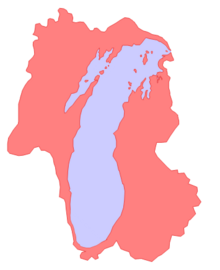
Twelve million people live along Lake Michigan's shores, mainly in theChicagoandMilwaukeemetropolitan areas. The economy of many communities innorthern MichiganandDoor County, Wisconsin,is supported bytourism,with large seasonal populations attracted by Lake Michigan.[38]Many seasonal residents have summer homes along the waterfront and return to other homes for the winter. The southern tip of the lake near Gary, Indiana, is heavily industrialized.
Cities on the shores of Lake Michigan include:
Illinois
- Chicago
- Evanston
- Wilmette
- Winnetka
- Kenilworth
- Glencoe
- Highland Park
- Lake Forest
- Lake Bluff
- Naval Station Great Lakes
- North Chicago
- Waukegan
- Beach Park
- Zion
- Winthrop Harbor
Indiana
Michigan
- Benton Harbor
- Bridgman
- Charlevoix
- Douglas
- Elberta
- Escanaba
- Ferrysburg
- Frankfort
- Gladstone
- Glenn
- Grand Beach
- Grand Haven
- Harbor Springs
- Ludington
- Manistee
- Manistique
- Menominee
- Michiana
- Muskegon
- New Buffalo
- Norton Shores
- Pentwater
- Petoskey
- Saugatuck
- St. Joseph
- Shoreham
- South Haven
- Traverse City
Wisconsin
- Algoma
- Bay View
- Cudahy
- Fox Point
- Green Bay
- Kenosha
- Kewaunee
- Manitowoc
- Marinette
- Milwaukee
- Mequon
- Oconto
- Port Washington
- Racine
- Saint Francis
- Sheboygan
- Shorewood
- South Milwaukee
- Sturgeon Bay
- Two Rivers
- Whitefish Bay
- Waterford
-
TheMilwaukeelakefront
-
Silhouette of Chicago at the horizon
-
Chicago'sOak Street Beach
Parks
[edit]TheNational Park Servicemaintains theSleeping Bear Dunes National LakeshoreandIndiana Dunes National Park.Parts of the shoreline are within theHiawatha National Forestand theManistee National Forest.The Manistee National Forest section of the shoreline includes theNordhouse Dunes Wilderness.The Lake Michigan division of theMichigan Islands National Wildlife Refugeis also within the lake, as are theGreen Bay National Wildlife Refugeand theWisconsin Shipwreck Coast National Marine Sanctuary.
There are numerous state and local parks located on the shores of the lake or on islands within the lake:
- Chicago Park District Beaches
- Duck Lake State Park
- Fayette Historic State Park
- Fisherman's Island State Park
- Grand Haven State Park
- Grand Mere State Park
- Harrington Beach State Park
- Holland State Park
- Hoffmaster State Park
- Illinois Beach State Park
- Indian Lake State Park
- Indiana Dunes State Park
- Kohler-Andrae State Park
- Lake Park, Milwaukee
- Ludington State Park
- Leelanau State Park
- Mears State Park
- Muskegon State Park
- Newport State Park
- Orchard Beach State Park
- Peninsula State Park
- Pere Marquette Beach
- Potawatomi State Park
- Racine Zoo
- Rock Island State Park
- Saugatuck Dunes State Park
- Shingleton Management Unit within theLake Superior State Forest
- Silver Lake State Park
- Traverse City State Park
- Terry Andrae State Park
- Van Buren State Park
- Warren Dunes State Park
- Wells State Park
- Whitefish Dunes State Park
- Wilderness State Park
-
Big Sable Point,Michigan in Ludington State Park
-
Lake view from theSleeping Bear Dunes National Lakeshore,with people climbing uphill
-
Sleeping Bear Dunes from the Empire Bluffs Trail nearEmpire, Michigan
-
Eichelman Park inKenosha, Wisconsin,with Lake Michigan in the background
-
Lake Michigan and the Chicago skyline fromPortage, Indiana
-
Sunset at Nordhouse Dunes
Human activities
[edit]Fishing
[edit]
Lake Michigan is home to a small variety of fish species and other organisms. It was originally home tolake whitefish,lake trout,yellow perch,panfish,largemouth bass,smallmouth bassandbowfin,as well as some species ofcatfish.As a result of improvements to theWelland Canalin 1918, an invasion ofsea lampreysandoverharvesting,there has been a decline in native lake trout populations, ultimately causing an increase in the population of another invasive species, thealewife.As a result, salmonids, including various strains ofbrown trout,steelhead (rainbow trout),cohoandchinook salmon,were introduced as predators in order to decrease the wildlife population. This program was so successful that the introduced population of trout and salmon exploded, resulting in the creation of a large sport fishery for these introduced species. Lake Michigan is now stocked annually with steelhead, brown trout, and coho and chinook salmon, which have also begun natural reproduction in some Lake Michigan tributaries. However, several introduced invasive species, such as lampreys,round goby,zebra musselsandquagga mussels,continue to cause major changes inwater clarityand fertility, resulting in knock-on changes to Lake Michigan's ecosystem, threatening the vitality of native fish populations.
Fisheries in inland waters of the United States are small compared to marine fisheries. The largest fisheries are the landings from the Great Lakes, worth about $14 million in 2001.[39]Michigan's commercial fishery today consists mainly of 150 tribe-licensed commercial fishing operations through the Chippewa-Ottawa Resource Authority and tribes belonging to the Great Lakes Indian Fish and Wildlife Commission, which harvest 50 percent of the Great Lakes commercial catch in Michigan waters, and 45 state-licensed commercial fishing enterprises.[40]The prime commercial species is the lake whitefish. The annual harvest declined from an average of 11 million pounds (5,000,000 kg) from 1981 through to 1999 to more recent annual harvests of 8 to 9.5 million pounds (3,600,000 to 4,300,000 kg). The price for lake whitefish dropped from $1.04/lb. to as low as $0.40/lb during periods of high production.[40]
Sports fishing includes salmon, whitefish,smelt,lake trout andwalleyeas major catches. In the late 1960s, successful stocking programs for Pacific salmon led to the development of Lake Michigan's charter fishing industry.[41]
Shipping
[edit]Like all of the Great Lakes, Lake Michigan is today used as a majormode of transportfor bulk goods. In 2002, 162 million nettonsof dry bulk cargo were moved via the Lakes. This was, in order of volume: iron ore, grain andpotash.[42]The iron ore and much of the stone and coal are used in the steel industry. There is also some shipping of liquid and containerized cargo, but most container vessels cannot pass the locks on theSaint Lawrence Seawaybecause the ships are too wide. The total amount of shipping on the lakes has been on a downward trend for several years. ThePort of Chicago,operated by theIllinois International Port District,has grain (14 million bushels) and bulk liquid (800,000 barrels) storage facilities alongLake Calumet.The central element of the Port District,Calumet Harbor,is maintained by theU.S. Army Corps of Engineers.[43]
Ferries
[edit]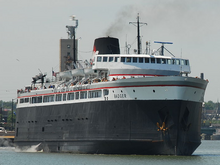
Two passenger and vehicle ferries operate ferry services across Lake Michigan, both connecting Wisconsin on the western shore with Michigan on the east. From May to October, the historic steamship,SSBadger,operates daily between Manitowoc, Wisconsin, and Ludington, Michigan,[44]connectingU.S. Highway 10between the two cities. TheLake Express,established in 2004, carries passengers and vehicles across the lake between Milwaukee, Wisconsin, and Muskegon, Michigan.
Tourism and recreation
[edit]Tourism and recreation are major industries on all of the Great Lakes. A few small cruise ships operate on Lake Michigan, including a couple of sailing ships. Many other water sports are practiced on the lakes, such as yachting, sea kayaking, diving, kitesurfing and lake surfing.Great Lakes passenger steamershave been operating since the mid-19th century. Several ferries currently operate on the Great Lakes to carry passengers to various islands, includingBeaver IslandandBois Blanc Island (Michigan).Currently, two car ferry services traverse Lake Michigan from around April to November: the SS Badger, a steamer from Ludington, Michigan, to Manitowoc, Wisconsin, and theLake Express,a high speed catamaran from Milwaukee to Muskegon, Michigan.
TheGreat Lakes Circle Tour,a designated scenic road system, connects all of the Great Lakes and the St. Lawrence River.[45]The lake is a great place to view ice volcanoes,[46]which typically occur at the start of thewinterseason.
-
Lake Michigan beach atHolland State Parkin Park Township, Michigan
-
Chicago'sNorth Avenue Beach,Lincoln Park
See also
[edit]References
[edit]- ^National Geophysical Data CenterArchivedApril 3, 2015, at theWayback Machine,1996. Bathymetry of Lake Michigan. National Geophysical Data Center, NOAA. doi:10.7289/V5B85627 [access date: March 23, 2015].
- ^National Geophysical Data CenterArchivedApril 3, 2015, at theWayback Machine,1999. Bathymetry of Lake Huron. National Geophysical Data Center, NOAA. doi:10.7289/V5G15XS5 [access date: March 23, 2015]. (only small portion of this map)
- ^National Geophysical Data Center, 1999.Global Land One-kilometer Base Elevation (GLOBE) v.1.ArchivedFebruary 10, 2011, at theWayback MachineHastings, D. and P.K. Dunbar. National Geophysical Data Center, NOAA. doi:10.7289/V52R3PMS [access date: March 16, 2015].
- ^"About Our Great Lakes: Tour".National Oceanic and Atmospheric Administration (NOAA), Great Lakes Environmental Research Laboratory (GLERL). Archived fromthe originalon May 7, 2017.RetrievedDecember 15,2017.
- ^ab"Lake Michigan".Great-lakes.net. June 18, 2009. Archived fromthe originalon January 1, 2010.RetrievedJanuary 14,2010.
- ^abcdefWright 2006,p. 64
- ^Shorelines of the Great LakesArchivedApril 5, 2015, at theWayback Machine
- ^"Mackinac Bridge History, Facts and Figures".Archivedfrom the original on January 22, 2018.RetrievedAugust 21,2022.
- ^"Great Lakes Map".Michigan Department of Environmental Quality.2013.Archivedfrom the original on November 26, 2011.RetrievedAugust 26,2013.
- ^Routley, Nick (February 23, 2019)."The World's 25 Largest Lakes, Side by Side".Visual Capitalist.Archivedfrom the original on June 21, 2021.RetrievedDecember 19,2020.
- ^first form is as spelled inOjibwe native syllabics
- ^"Superior Watershed Partnership Projects".Archived fromthe originalon September 28, 2007.
- ^Bogue 1985,pp. 7–13
- ^"1733d4".Archived fromthe originalon May 7, 2021.RetrievedNovember 6,2004.
- ^White, Richard(2011) [1991].The Middle Ground: Indians, Empires, and Republics in the Great Lakes Region, 1650–1815.Cambridge studies in North American Indian history (Twentieth Anniversary ed.). Cambridge University Press.ISBN978-1-107-00562-4.
- ^"Colonial Fort Michilimackinac".Mighty Mac.Archivedfrom the original on November 27, 2020.RetrievedJuly 6,2014.
- ^Bogue 1985,pp. 14–16
- ^Shelak 2003,p. 3
- ^Cronon, William (1991).Nature's Metropolis: Chicago and the Great West.New York, NY: W. W. Norton and Company. p. 87.ISBN9780393072457.
- ^Klump, J. Val; Paddock, Robert; Remsen, Charles C.; Fitzgerald, Sharon; Boraas, Martin; Anderson, Patrick (1989)."Variations in Sediment Accumulation Rates and the Flux of Labile Organic Matter in Eastern Lake Superior Basins".The Journal of Great Lakes Research.15(1): 104.Bibcode:1989JGLR...15..104K.doi:10.1016/S0380-1330(89)71465-9.Archived fromthe originalon December 3, 2012.RetrievedAugust 9,2009.
- ^Briscoe, Tony (September 16, 2018)."Lake Michigan is warming. A new report says that could mean trouble for game fish".Chicago Tribune.Archivedfrom the original on June 30, 2021.RetrievedSeptember 17,2018.
- ^abHilton 2002,pp. 3–5
- ^Briscoe, Tony (July 13, 2018)."What happens when Lake Superior has too much water?".Chicago Tribune.Archivedfrom the original on June 26, 2021.RetrievedJuly 15,2018.
- ^"Geophysical Lake Michigan".US Environmental Protection Agency.September 25, 2015.Archivedfrom the original on January 12, 2019.RetrievedMarch 16,2017.
- ^ab"Chart: 14901 Edition: 15 Edition Date: August 2006 Clear Dates: NM – 12/17/2011 LNM – 12/6/2011"; "Soundings in feet and fathoms".NOAA.Archivedfrom the original on April 22, 2021.RetrievedSeptember 18,2013.
- ^"michiganlarge".NOAA National Centers for Environmental Information.Archived fromthe originalon March 21, 2021.RetrievedMarch 16,2017.
- ^"Bathymetry of Lake Michigan".ngdc.noaa.gov.Archivedfrom the original on July 15, 2018.RetrievedMarch 16,2017.
- ^abcMonthly bulletin of Lake Levels for The Great Lakes; September 2009; U.S. Army Corps of Engineers, Detroit District
- ^abc"Great Lakes Water Level Data".February 3, 2021.Archivedfrom the original on May 27, 2021.RetrievedFebruary 9,2021.
- ^abBivins, Larry (April 3, 2013)."Low Great Lakes water levels plague shipping, recreation".USA Today.Archivedfrom the original on February 28, 2020.RetrievedSeptember 2,2017.
- ^Flesher, John (February 5, 2013)."Two Great Lakes hit lowest water levels since record keeping began nearly a century ago".Vancouver Sun.Archived from<ury/7923713/story.html#ixzz2RxYTXcZr the originalon February 12, 2013.
- ^"Lake Michigan at Near-Record High Water Levels".National Weather Service.Archivedfrom the original on January 18, 2021.RetrievedDecember 9,2019.
- ^Hawthorne, Michael (July 15, 2007)."BP gets break on dumping in lake".Chicago Tribune.Archivedfrom the original on June 22, 2021.RetrievedOctober 14,2020.
- ^Hawthorne, Michael (March 28, 2014)."BP raises estimate of Lake Michigan oil spill".Chicago Tribune.Archivedfrom the original on November 17, 2020.RetrievedOctober 14,2020.
- ^"NOAA Great Lakes Region".NOAA.Archivedfrom the original on April 21, 2021.RetrievedSeptember 15,2015.
- ^"Michigan Sea Grant Coastwatch".Coastwatch.msu.edu. Archived fromthe originalon February 12, 2010.RetrievedJanuary 14,2010.
- ^Wolgamott, K. (May 17, 2018). "Where to Find Petoskey Stones in Michigan." Retrieved fromhttps:// michigan.org/article/trip-idea/where-find-petoskey-stones-michiganArchivedJune 24, 2021, at theWayback Machine
- ^"Economic Vitality and the Great Lakes | Michigan Sea Grant".Archived fromthe originalon December 19, 2017.RetrievedFebruary 3,2018.
- ^NOAA/NMFS:(2001)Fisheries of the United States, 2003ArchivedAugust 10, 2007, at theWayback Machine
- ^abMichigan Commercial Fisheries Marketing and Product Development(PDF)(Report). Ann Arbor, Michigan: University of Michigan Sea Grant. Archived fromthe original(PDF)on April 12, 2013.RetrievedApril 30,2013.
- ^O'Keefe, Dan (2009).Charter Fishing in Michigan: A Profile of Customers and Economic Impacts(PDF)(Report). Ann Arbor, Michigan: University of Michigan Sea Grant.Archived(PDF)from the original on May 13, 2017.RetrievedApril 30,2013.
- ^Great Lakes Shipping Study(PDF)(Report). U.S. Department of Homeland Security. January 13, 2014. Archived fromthe original(PDF)on November 11, 2020.RetrievedMay 30,2018.
- ^U.S. Army Corps of Engineers (November 2007)."Calumet Harbor, IL and IN"ArchivedOctober 23, 2020, at theWayback Machine.Retrieved on July 31, 2014.
- ^"Schedule and Fares".SS Badger.Archivedfrom the original on May 7, 2021.RetrievedApril 1,2018.
- ^"Great Lakes Circle Tour".Great-lakes.net. July 5, 2005. Archived fromthe originalon July 25, 2010.RetrievedFebruary 19,2011.
- ^"Ice Volcanoes Explode Along Lake Michigan as Ice Balls Line Shoreline: NWS".February 17, 2020.Archivedfrom the original on March 1, 2021.RetrievedFebruary 18,2020.
Further reading
[edit]- Bogue, Margaret Beattie (1985).Around the Shores of Lake Michigan: A Guide to Historic Sites.University of Wisconsin Press.ISBN0-299-10004-9.
- Hilton, George Woodman (2002).Lake Michigan Passenger Steamers.Stanford University Press.ISBN0-8047-4240-5.
- Hyde, Charles K.; Mahan, Ann; Mahan, John (1995).The Northern Lights: Lighthouses of the Upper Great Lakes.Detroit:Wayne State University Press.ISBN978-0-814325-54-4.
- Oleszewski, Wes (1998).Great Lakes Lighthouses, American and Canadian: A Comprehensive Directory/Guide to Great Lakes Lighthouses.Gwinn:Avery Color Studios, Inc.ISBN0-932212-98-0.
- Penrod, John (1998).Lighthouses of Michigan.Berrien Center:Pernod/Hiawatha.ISBN978-0-942618-78-5.
- Penrose, Laurie; Penrose, Bill (1999).A Traveler's Guide to 116 Michigan Lighthouses.Petoskey:Friede Publications.ISBN978-0-923756-03-1.
{{cite book}}:CS1 maint: location missing publisher (link) - Shelak, Benjamin J. (2003).Shipwrecks of Lake Michigan.Big Earth Publishing.ISBN1-931599-21-1.
- Wagner, John L. (1998).Michigan Lighthouses: An Aerial Photographic Perspective.East Lansing:John L. Wagner.ISBN978-1-880311-01-1.
- Wright, John W., ed. (2006).The New York Times Almanac.Editors and reporters ofThe New York Times(2007 ed.). New York, New York: Penguin Books.ISBN0-14-303820-6.
- Wright, Larry; Wright, Patricia (2006).Great Lakes Lighthouses Encyclopedia(Hardback ed.). Erin: Boston Mills Press.ISBN1-55046-399-3.
External links
[edit] Geographic data related toLake MichiganatOpenStreetMap
Geographic data related toLake MichiganatOpenStreetMap- EPA's Great Lakes AtlasArchivedOctober 29, 2010, at theWayback Machine
- Great Lakes Coast WatchArchivedMay 11, 2008, at theWayback Machine
- Michigan DNR map of Lake MichiganArchivedJune 21, 2007, at theWayback Machine
- Official Michigan DNR Freshwater Fishing RegulationsArchivedJanuary 29, 2021, at theWayback Machine
- Bathymetry of Lake MichiganArchivedMay 9, 2021, at theWayback Machine
- .Collier's New Encyclopedia.1921.
- Anderson, William P.(1911)..Encyclopædia Britannica(11th ed.).
- .New International Encyclopedia.1905.
Lighthouses
[edit]- Bibliography on Michigan lighthouses
- Interactive map of lighthouses in area (northern Lake Michigan)
- Interactive map of lighthouses in area (southern Lake Michigan)[permanent dead link]
- Terry Pepper on lighthouses of the western Great Lakes
- Wagner, John L., Beacons Shining in the NightArchivedAugust 22, 2021, at theWayback Machine,Michigan lighthouse bibliography, chronology, history, and photographs, Clarke Historical Library, Central Michigan University
- Lake Michigan
- Lakes of Illinois
- Lakes of Indiana
- Lakes of Michigan
- West Michigan
- Northern Michigan
- Lakes of Wisconsin
- Borders of Wisconsin
- Borders of Michigan
- Borders of Indiana
- Borders of Illinois
- Lakes of Door County, Wisconsin
- Lakes of Cook County, Illinois
- Lakes of Lake County, Illinois
- Bodies of water of LaPorte County, Indiana
- Lakes of Muskegon County, Michigan
- Lakes of Berrien County, Michigan
- Lakes of Grand Traverse County, Michigan
- Lakes of Manistee County, Michigan
- Lakes of Leelanau County, Michigan
- Great Lakes
- Lakes of Kewaunee County, Wisconsin
- Bodies of water of Milwaukee County, Wisconsin
- Bodies of water of Brown County, Wisconsin
- Lakes of Kenosha County, Wisconsin
- Bodies of water of Manitowoc County, Wisconsin
- Bodies of water of Ozaukee County, Wisconsin
- Bodies of water of Oconto County, Wisconsin
- Bodies of water of Racine County, Wisconsin
- Lakes of Sheboygan County, Wisconsin
- Michigan State Historic Sites in Mackinac County

